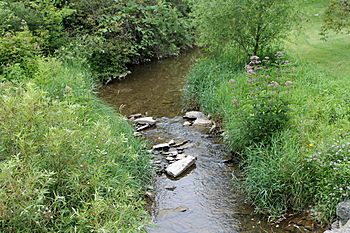Kase Run facts for kids
Quick facts for kids Kase Run |
|
|---|---|

Kase Run looking downstream in its lower reaches
|
|
| Physical characteristics | |
| Main source | pond in West Hemlock Township, Montour County, Pennsylvania 940 feet (290 m) |
| River mouth | Mahoning Creek in Valley Township, Montour County, Pennsylvania 518 feet (158 m) |
| Length | 4.6 miles (7.4 km) |
| Basin features | |
| Progression | Mahoning Creek → Susquehanna River → Chesapeake Bay |
| Basin size | 7.27 square miles (18.8 km2) |
Kase Run is a stream in Montour County, Pennsylvania. It flows into Mahoning Creek. The stream is about 4.6 miles (7.4 km) long. It flows through West Hemlock Township and Valley Township. The area of land that drains into Kase Run is 7.27 square miles (18.8 km2).
The Pennsylvania Department of Environmental Protection says that Kase Run and some of its smaller streams are affected by too much siltation. This means fine dirt and mud are building up, mostly because of farming activities. Kase Run is known as a coldwater fishery, which means its waters are cool enough for certain fish.
Contents
Where Kase Run Flows
Kase Run starts in a small pond in eastern West Hemlock Township. It begins just south of Styer Road. The stream first flows southwest into a valley. After about 0.25 miles (0.40 km), it turns south and stays in the valley.
Further along, Kase Run turns southwest again, then south. It then leaves the valley and turns west. Eventually, it enters Valley Township. The stream continues west for a bit before turning southwest. It then flows under Interstate 80. Less than a mile after crossing the interstate, Kase Run meets Mahoning Creek. It joins Mahoning Creek about 4.70 miles (7.56 km) upstream from where Mahoning Creek ends.
Water Quality
The water in Kase Run is not super warm or super cold. This was noted by A. Joseph Armstrong in his book Trout Unlimited's Guide to Pennsylvania Limestone Streams.
Most of Kase Run is considered "impaired" by the Pennsylvania Department of Environmental Protection. This means its water quality isn't as good as it should be. Several smaller streams that flow into Kase Run are also impaired. The main problem is siltation, which is when fine dirt and mud build up in the water. This often happens because of agriculture (farming).
Rocks and Soil Around the Stream
The land around Kase Run has different types of rock. Near the lower parts of the stream, you'll find rocks from the Wills Creek Formation. In the middle sections, the rocks are from the Hamilton Group. The upper parts of the stream flow over rocks from the Trimmers Rock Formation and the Catskill Formation. Some of the smaller streams that feed into Kase Run flow over rocks from the Bloomsburg, Mifflintown Formation, and the Clinton Group.
The soil near where Kase Run begins is called the Leck Kill-Minersville-Calvin soil series. In the rest of the stream's watershed, the soil is known as the Berks-Weikert-Bedington soil series.
The banks along Kase Run are all less than 6 feet (1.8 m) high. Some banks are gently sloped, while others are very steep. Most of the banks are made of sand and clay, but some are made of small rocks.
What the Stream Looks Like
Kase Run can be anywhere from 7 to 15 feet (2.1 to 4.6 m) wide. It is a freestone stream, which means its water comes mostly from rainfall and melting snow, not from underground springs.
Near its mouth, Kase Run is about 518 feet (158 m) above sea level. Where it starts, the stream is much higher, around 940 feet (290 m) above sea level.
Along Kase Run, there are 78 "disturbances." These include:
- 34 places where the banks are eroding (wearing away).
- 24 places where sand and dirt have built up.
- Eight smaller streams flowing into Kase Run.
- Three bridges.
- Three pipes.
- Two areas with riprap (rocks used to prevent erosion).
- One small dam.
- One ford (a shallow place to cross the stream).
Its Surroundings
The watershed of Kase Run covers an area of 7.27 square miles (18.8 km2). Most of this area is in Montour County, but a small part is in Columbia County. A lot of the land along the stream is used for farming or has buildings on it. However, there are also forested areas, especially near where the stream begins.
There are about 18.67 miles (30.05 km) of streams in the Kase Run watershed. About 1.617 miles (2.602 km) of these streams are not meeting water quality standards.
A Look Back in Time
Kase Run was probably named after Abraham Kase. He owned land along the stream in the early 1800s.
Three bridges were built over Kase Run in 1963. Two of these bridges carry Interstate 80 over the stream.
In 2007, there was an incident where heating oil spilled at a home. Some of this oil reached a small stream that flows into Kase Run. The company responsible was fined $8500 by the Pennsylvania Department of Environmental Protection.
Historically, Kase Run used to be larger than it is today.
Plants and Animals
Even though Isonychia mayflies live in Kase Run, you won't find any trout there. The stream is still designated as a coldwater fishery, meaning it has the right conditions for coldwater fish, even if trout aren't currently present.
Experts from the Montour County Natural Areas Inventory suggest planting native trees along Kase Run. This would help reduce non-point source pollution, which is pollution that comes from many different sources, like runoff from farms or roads.
The vegetation (plants) covering the streambanks varies. One bank is more than 60 percent covered by plants. Many others are between 30 and 60 percent covered, and some have less than 30 percent plant cover.

